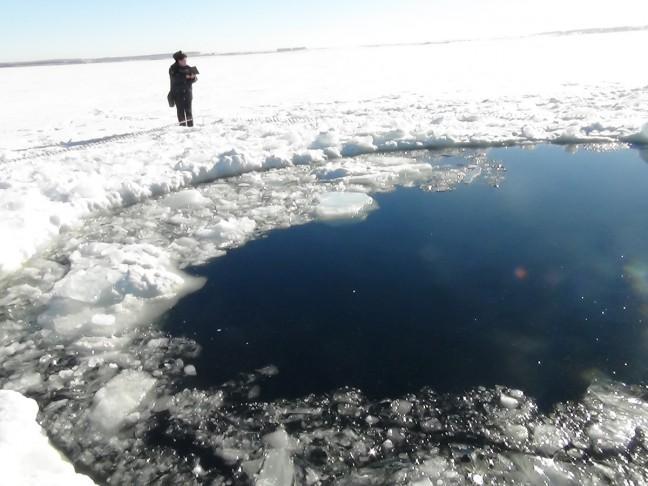The Polar Radiant Energy in the Far InfraRed Experiment — or PREFIRE — team at the University of Wisconsin is collaborating with NASA’s Jet Propulsion Laboratory to get a better understanding of far-infrared radiation’s impacts on the Arctic’s climate.
PREFIRE will launch two small satellites the size of cereal boxes, called CubeSats, to measure far-infrared radiation over Earth, principal investigator at PREFIRE and director of the Cooperative Institute for Meteorological Studies Tristan L’Ecuyer said.
Far-infrared radiation has never been systematically collected on Earth before, according to L’Ecuyer. But, L’Ecuyer said measuring far-infrared radiation will give scientists new information about emissivity, or how much energy the surface of the earth absorbs and emits. The data will also provide more information about water vapor and clouds — especially ice clouds.
UW researchers employ virtual reality technology to reimagine scientific exploration
“There’s excitement in the fact that we’ll be able to do better climate predictions, we know that,” L’Ecuyer said. “But there’s also excitement in just looking at the data and seeing something completely new that we’ve never seen before … What new things that we’ve never even thought of will we be able to learn from these measurements?”
Far-infrared radiation on Earth has only been measured from space once — L’Ecuyer said data was collected for a couple of days in the 1970s, and some researchers have made a few ground measurements. L’Ecuyer said he hopes PREFIRE’s CubeSats will remain in orbit for over one year.
The Earth’s atmosphere balances the energy it receives from the sun by emitting infrared radiation back into space, L’Ecuyer said. In the past, scientists have only measured about half of the spectrum of Earth’s infrared emissions, but L’Ecuyer said PREFIRE will measure the other half.
University collaborates with Racine, Gateway Technical College to study autonomous vehicles
Several groups of UW researchers will be able to use the new data collected by the PREFIRE mission. L’Ecuyer said the data will be useful for the Antarctic Meteorological Research Center, the Department of Geoscience, the Atmospheric Science Department and many others to improve the research of sea ice, melting glaciers, clouds, water vapor, energy balance, climate modeling and climate forecasting.
L’Ecuyer said he’s also working with NASA to send students on a field campaign in the Arctic to verify the CubeSats’ measurements and perform some fieldwork. Students have been involved in every phase of the PREFIRE mission.
“More than half of our team right now is made up of students,” L’Ecuyer said. “They’re involved in the calibration of the instrument, they’re involved in predicting what our measurements are going to tell us about clouds and about water vapor and [they’re] actually developing the algorithms that will eventually create the products from this.”
Remodeled Chemistry Building aims to bring collaboration to STEM education
One of these students is Meredith Grames, a third-year graduate student studying atmospheric science with a focus in atmospheric radiation and remote sensing. Grames is working with the atmospheric retrieval group to develop an algorithm to retrieve temperature and water vapor data from the CubeSats’ measurements.
Grames said working with PREFIRE has allowed her to gain experience working with experts and professionals in the field.
“Everything about this mission has been a learning experience, which I think has been fun,” Grames said. “As a student learning the whole process of what goes into a satellite mission has been really fascinating.”
One of the main challenges in Grames’ work is figuring out how to write an algorithm to visualize measurements that haven’t been taken before. L’Ecuyer said a challenge for the mission as a whole has been configuring the technology to fit on a CubeSat, which runs on less power than a lightbulb and has to transmit data from space to Earth.
Future warming climates will result in new plant interactions, competition
The Jet Propulsion Lab and Blue Canyon Technologies are working to engineer the CubeSat, and L’Ecuyer said they have made the technology very reliable. The satellite should operate with power for at least a year, but it could potentially provide the team with data for up to four years.
The pandemic was another hurdle for the PREFIRE mission. L’Ecuyer said engineers working on the far-infrared measurement technology couldn’t work in the lab at the same time, which greatly slowed the engineering process.
Supply chain issues also caused shipping delays for integral parts of the measurement technology, L’Ecuyer said. In some cases, the project had to wait for parts to arrive to continue manufacturing the instrument because the engineers couldn’t move on without testing them.
What the James Webb Space Telescope can offer us over next five years
The Jet Propulsion Lab is building the instrument that will measure far-infrared radiation, along with Oxford University and a company in California. L’Ecuyer said that once the Jet Propulsion Lab finalizes the measuring instrument, they will send it to Blue Canyon Technologies. Blue Canyon Technologies is building the CubeSat, which will be shipped to a launch site in the U.S. to be put into orbit.
UW is working on the science behind the mission, L’Ecuyer said, which includes performing data analysis and developing algorithms to interpret the data from the CubeSats. While the main focus of the project is on the Arctic, L’Ecuyer said the data could allow researchers to see things they’ve never studied before all over the globe.
“I think what’s super exciting is just looking, we’re going to see things that we never expected to see in these measurements and it might not even be in the poles,” L’Ecuyer said. “It might be in the tropics, or might be over the U.S. or somewhere out over in the middle of the ocean.”


















